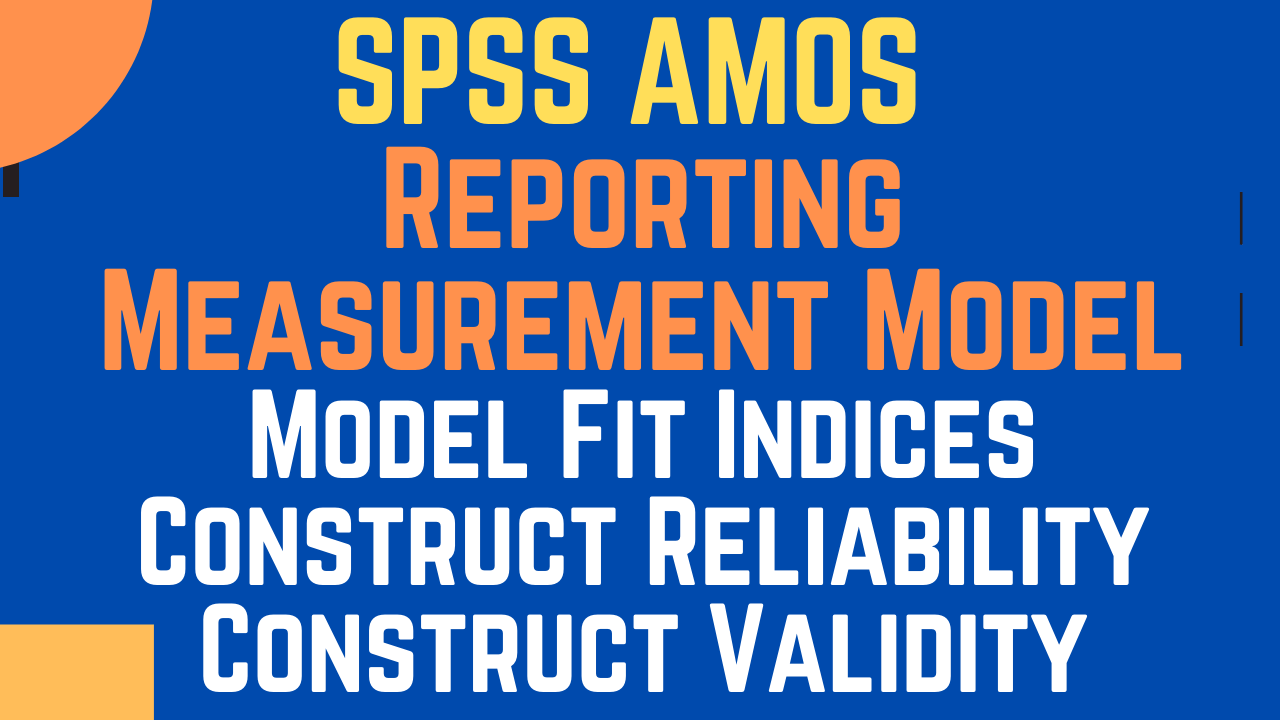How to Report Measurement Model from SPSS AMOS

IBM SPSS AMOS Series
In this session the scholars will learn how to report Measurement model that includes Model Fit Indices, Construct Reliability, Construct Validity including Convergent and Discriminant Validity.
Reporting Measurement Model
Ingredients
- Model Fit Statistics (Chi-Square, CMIN, CFI, TLI, RMSEA, SRMR)
- Factor Loadings
- Cronbach’s Alpha
- Composite Reliability
- Average Variance Extracted for Convergent Validity
- Discriminant Validity
- Fornell & Larcker Criterion
- Heterotrait-Monotrait Ratio
Reporting Model Fit - Sample
Model Fit Statistics (CMIN/df, GFI, CFI, TLI, SRMR, and RMSEA)
Confirmatory Factor Analysis (CFA) was computed using AMOS to test the measurement models. As part of confirmatory factor analysis, factor loadings were assessed for each item, one item (LS5) was removed due to low factor loadings (< .50). The model-fit measures were used to assess the model’s overall goodness of fit (CMIN/df, GFI, CFI, TLI, SRMR, and RMSEA) and all values were within their respective common acceptance levels (Ullman, 2001; Hu and Bentler, 1998, Bentler, 1990). The three-factor model (Authentic leadership, Ethical Leadership, and Life Satisfaction) yielded good fit (Table 1) for the data: CMIN/df = , GFI = , CFI = , TLI = , SRMR = , and RMSEA=.
Reporting Construct Reliability - Sample
Construct Reliability was assessed using Cronbach’s Alpha and Composite Reliability. Cronbach Alpha for each construct in the study was found over the required limited of .70 (Nunnally and Bernstein, 1994). Composite reliabilities ranged from _____ to _____, above the 0.70 benchmark (Hair et al., 2010). Hence, construct reliability was established for each construct in the study.
Reporting Convergent Validity - Sample
Convergent validity of scale items was estimated using Average Variance extracted (Fornell & Larcker,1981). The average variance-extracted values were above the threshold value of 0.50 (Fornell & Larcker,1981) Therefore, the scales used for the present study have the required convergent validity.
Reporting Discriminant Validity - Sample
Discriminant validity in the study was assessed using Fornell and Larcker Criterion and Heterotrait-Monotrait (HTMT) Ratio. According to Fornell and Larcker criterion, discriminant validity is established when the square root of AVE for a construct is greater than its correlation wit the other constructs in the study. However, Fornell and Larcker criterion has recently been criticized and a new method to assess the discriminant validity that is HTMT ratio is increasingly utilizedIn the present study, discriminant validity is not entirely established using Fornell and Larcker criterion. However, when assessed using HTMT ratio, all ratios were less than the required limit of .85 (Henseler et al., 2015). Hence, discriminant validity was established.
References
- Bentler, P. M. (1990). Comparative fit indexes in structural models. Psychological bulletin, 107(2), 238.
- Fornell, C., & Larcker, D. F. (1981). Structural equation models with unobservable variables and measurement error: Algebra and statistics.
- Henseler, J., Ringle, C. M., & Sarstedt, M. (2015). A new criterion for assessing discriminant validity in variance-based structural equation modeling. Journal of the academy of marketing science, 43(1), 115-135.
- Hu, L. T., & Bentler, P. M. (1998). Fit indices in covariance structure modeling: Sensitivity to underparameterized model misspecification. Psychological methods, 3(4), 424.
- Ullman, J. B. (2001). Structural equation modeling. In B. G. Tabachnick & L. S. Fidell (2001). Using Multivariate Statistics (4th ed& pp 653- 771). Needham Heights, MA: Allyn & Bacon.
Video Tutorials
Additional SPSS AMOS Resources
- Assessing Construct Reliability and Convergent Validity in SPSS AMOS
- Basic/First Structural Model in SPSS AMOS
- Building a Basic Model in SPSS AMOS
- Common Method Bias in SPSS AMOS
- Common Method Bias using Latent Common Method Factor
- Confirmatory Factor Analysis and Analyzing SPSS AMOS Output
- First Measurement Model in AMOS
- Full Structural Model Analysis
- How to Assess Discriminant Validity in SPSS AMOS
- IBM SPSS AMOS Lecture Series – Basics
- IBM SPSS AMOS Series – 2 – What is Structural Equation Modelling
- IBM SPSS AMOS Series – 4 – Introduction to AMOS
- IBM SPSS AMOS Series – Factor Loadings and Fit Statistics
- Introduction to Confirmatory Factor Analysis (CFA)
- Mediation Analysis with Multiple Mediators
- Moderation Anlaysis in SPSS AMOS
- Moderation Anlaysis with Categorical Moderator in SPSS AMOS
- Serial Mediation Analysis in SPSS AMOS
- SPSS AMOS Assessing Normality of Data
- SPSS AMOS Mediation Analysis
- Understanding, Assessing, and Improving Model fit in SPSS AMOS